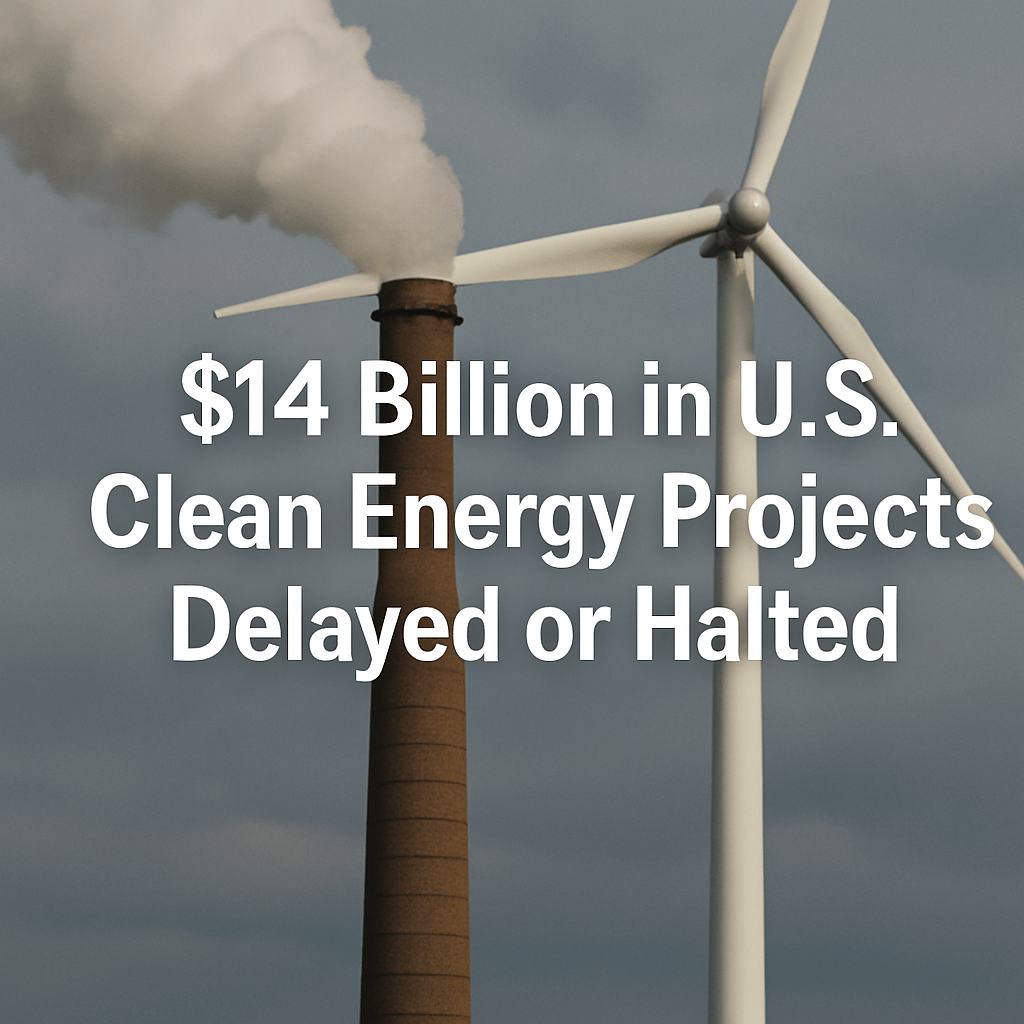$14 Billion in U.S. Clean Energy Projects Delayed or Halted

Summary of Cancellations and Delays
According to a joint analysis by nonpartisan group E2 and consultancy Atlas Public Policy, more than $14 billion in clean energy investments in the U.S. have been canceled or delayed through mid-2025. The bulk of these losses—over $12 billion—occurred in Republican-led states and congressional districts. Companies cite rising policy uncertainty following the House Republicans’ passage of a tax bill that would substantially reduce or eliminate renewables incentives enacted under the 2022 Inflation Reduction Act (IRA). E2 estimates these project withdrawals have cost roughly 10,000 potential jobs in solar, wind, battery storage, electric vehicle (EV) manufacturing and other renewables segments.
Major Affected Sectors
- Battery Storage: The cancellation of Kore Power’s proposed 4 GWh battery cell factory in Arizona and the suspension of Bosch’s $200 million hydrogen fuel cell plant in South Carolina.
- EV Manufacturing: BorgWarner closing two powertrain assembly lines in Michigan and other OEMs pausing new model rollouts amid shifting credit structures.
- Solar and Wind Installations: Utility-scale projects totaling over $2 billion put on hold in red states where developers now face uncertainty over production tax credits (PTCs) and investment tax credits (ITCs).
- Hydrogen Fuel Cells: Delays in commissioning proton exchange membrane (PEM) stacks and associated electrolyzer facilities due to shifting policy guidance on green hydrogen incentives.
Technical Challenges and Market Dynamics
The retrenchment has been exacerbated by broader market forces:
- Supply Chain Constraints: Critical minerals like lithium, nickel and cobalt face export restrictions from China and rising freight costs. Battery-grade lithium hydroxide spot prices climbed over +35% year-on-year in Q1, pushing projected module costs above $120/kWh for NMC chemistries.
- Levelized Cost of Energy (LCOE): Solar PV LCOE has fallen below $30/MWh in ideal regions, but interconnection queues and grid upgrade charges are inflating final tariffs by 15–20%.
- Technology Adoption Rates: EV sales growth decelerated to 9.5% year-on-year in Q1 2025, down from 12% in 2024, as consumer incentives and charging infrastructure expansion plateau.
Engineering experts, including Fengqi You at Cornell University, warn that removing or reducing tax credits midway through project development may strand assets in early‐stage engineering, procurement and construction (EPC) phases, leading to sunk costs and supply chain shocks.
Geopolitical and Policy Implications
The debate centers on the pending “megabill” in the House, which would repeal key provisions of the IRA, reversing:
- Solar ITCs and Wind PTCs that underpin project financing models.
- EV Credits tied to domestic assembly and critical mineral sourcing.
- Investment Leverage that has spurred over $132 billion in announced clean energy projects since 2022.
Internationally, the U.S. risks ceding leadership to the European Union’s Carbon Border Adjustment Mechanism (CBAM) and China’s state-backed battery giga-factories. The EU’s CBAM, slated for phased implementation in 2026, imposes tariffs on imported goods based on embedded carbon intensity, giving EU producers a competitive edge over U.S. exporters if domestic carbon policies weaken.
Future Outlook and Strategic Responses
The Senate, under a self-imposed July 4 deadline, is negotiating carve-outs that could preserve at least partial credit windows for ongoing projects. Several bipartisan senators have cautioned that a full repeal could:
- Trigger further offshoring of manufacturing capacity to Canada, Mexico and Europe.
- Undermine long-term private capital commitments in green infrastructure.
Investment funds are now reallocating capital toward jurisdictions with stable policy regimes. Morgan Stanley’s latest clean tech outlook suggests a 3–5% risk premium adjustment for U.S. renewable and battery projects versus European counterparts.
Additional Analysis: Comparative International Incentives
Countries such as Germany and South Korea are enhancing grants and low-interest loans for green hydrogen and advanced battery manufacturing. Germany’s €9 billion National Hydrogen Strategy and South Korea’s New Green Deal illustrate how consistent, technology-agnostic support can drive project pipelines even amid global economic headwinds.
Recommendations for Stakeholders
Industry groups advise developers to:
- Secure binding offtake agreements and hedge commodity exposures.
- Accelerate front-end engineering design (FEED) to lock in equipment prices.
- Engage with policymakers to craft bipartisan frameworks that balance fiscal discipline with clean energy goals.
Without a stable incentive regime, experts warn that the U.S. may lag in the next wave of green industrialization, ceding market share in battery cells, electrolyzers and solar modules to more policy-stable regions.